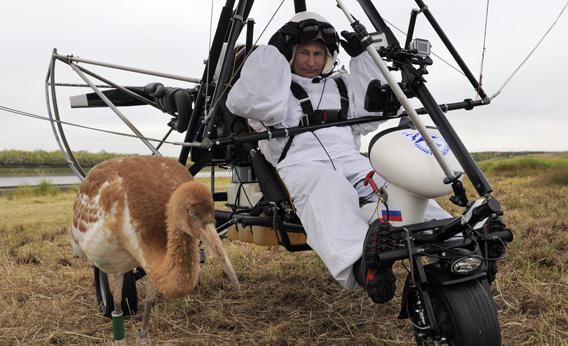Russian president Vladimir Putin attempted to lead a flock of captive-raised Siberian white cranes in flight this week as part of the birds’ training for winter migration. According to some accounts, the Russian leader even wore a glove designed to look like a beak. Are birds really willing to believe that a former KGB agent inside of a motorized hang glider is one of them, just because he’s wearing a fake beak?
Not exactly. Training captive migratory birds to follow a plane is a relatively simple process. When the birds are mere embryos, handlers treat them to the sounds of airplane engines through their eggshells. The birds see the plane for the first time around three days after hatching, and start hopping alongside it a few days later. Once they get their flight feathers, they go on brief training flights with the plane before eventually making the big migration. The human pilots always wear the same costume while flying to avoid confusing the animals, but it doesn’t matter if the human inside the aircraft bears any resemblance to a crane. In fact, ever since Konrad Lorenz persuaded a clutch of geese to follow him around in the 1930s, animal behaviorists have proven that, with enough early exposure, some species of birds can be convinced to follow almost any object. Laboratory birds have formed bonds with plastic boxes, flashing lights, and swinging pendulums, among many other decidedly nonornithomorphic items.
Some species seem to have preferences in imprinting, though. Birds prefer moving objects, as well as those that make sound. They are predisposed to bond with objects that have a head and neck, although stuffed cat models are just as effective as stuffed waterfowl. Researchers speculate that these preferences make young birds less likely to bond with bushes or twigs, which might be among the first things a hatchling sees. It should be noted that not all birds engage in the imprinting process. Some species refuse to follow a nonavian leader, possibly because they are born with an understanding of what their species looks like, an innate model that Lorenz called a “schema.”
Although birds don’t care what a human pilot is wearing during a guided migration, human costumes are important in the rearing of captive birds. Handlers at Operation Migration, an organization that teaches captive whooping cranes to fly south like their wild-born cousins, wear amorphous white jumpsuits with long sleeves, hoods, and reflective mylar eye coverings, so that the young birds won’t associate humans with food. They also wear a whooping crane puppet on their hands, in the hopes that the trainees will become comfortable around their own species.
President Putin reportedly had limited success in his first attempt at guided crane migration, convincing only one bird to follow him on the first flight and losing the majority of the flock on his second. His frustration is natural, because crane-wrangling requires practice. It’s very rare for all of the birds to immediately follow and stick with a single plane for the duration of a training flight. In many cases, conservation groups send up extra planes to corral the stragglers back into the main group in a sometimes comical process they call the “crane rodeo.” It’s risky to allow an untrained pilot to fly with the birds, as pilots often have to abort landings when a crane swerves in front of the aircraft just before it touches down. Newbie pilots have killed birds in collisions.
Got a question about today’s news? Ask the Explainer.
Explainer thanks Liz Condie of Operation Migration.
